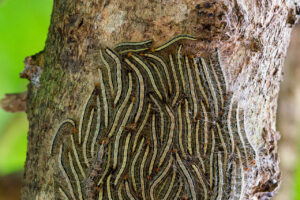Members of the public are being asked to remain vigilant after a number of oak trees in the Long Eaton area of Derbyshire were confirmed to be infested with the tree pest Oak Processionary Moth (OPM).
The trees are currently being treated and extensive surveillance work is ongoing to further investigate the findings and to direct appropriate control measures to prevent their potential spread.
Swift and robust action is being taken to identify the source of the outbreak, which has happened outside of OPM’s established area in London and some neighbouring counties. This includes implementing a rigorous management programme with the aim of eradicating the pest from this area, and extensively monitoring sites in the surrounding area through a programme of ground surveys and pheromone trapping.
Members of the public in Long Eaton and surrounding areas across Nottinghamshire and Derbyshire are urged to be especially vigilant and check for any signs of their own oak trees being infested, including those recently planted. OPM caterpillars have black heads and grey bodies covered in long white hairs, and they usually move nose-to-tail in a procession. OPM nests are typically dome or teardrop-shaped, averaging the size of a tennis ball. They are white when fresh, but soon become discoloured and brown. Please see our Forestry Commission infographic for further information on the characteristics of OPM.
If you spot the pest, please immediately report the sighting, with photos as supporting evidence, via our TreeAlert portal. Alternatively, you can email opm@forestrycommission.gov.uk or call 0300 067 4442. Owners and managers of oak trees can support the fight in tackling this pest by giving access to Forestry Commission surveyors to assess whether their trees are infested. OPM caterpillars and nests should not be touched under any circumstances.
Nicola Spence, UK Chief Plant Health Officer, said:
“Oak Processionary Moth is an insect pest of oak trees and poses a threat to both plant and human health. We are taking swift and effective action to treat the infested trees and to eradicate the pest from this area and prevent further spread in the surrounding area.
“The Government takes the management of Oak Processionary Moth very seriously and has a robust programme in place to reduce the level of pest prevalence and protect oak resource, whilst supporting landowners to manage the risks associated with OPM in the areas where it has been identified.”
Andrew Hoppit, Oak Processionary Moth Project Manager at the Forestry Commission, said:
“Following extensive surveillance, our experts have identified the presence of Oak Processionary Moth on several oak trees in Derbyshire.
“We are responding to the incident through our wider environment surveillance and trapping programme and are taking robust action to eradicate the pest.
“We encourage all members of the public in the Derbyshire area to remain vigilant for the pest and report any sightings to the Forestry Commission.”
Oak processionary moth (OPM) is native to southern Europe and is an insect pest of oak trees. It was first detected in London in 2006 and has since established in London and some surrounding counties, with the rest of the country designated a Pest Free Area. OPM poses a threat to oak trees and humans. Its caterpillars feed on the leaves of several species of oak trees, causing them to lose their leaves and negatively impact their growth. It can cause itchy rashes and eye and throat infections when touched by members of the public.
Since 2012, the Government has had a programme in place to minimise the size, spread and impact of OPM. Over the last five years, £10 million has been invested into oak health, including the management of oak processionary moth, as well as research to develop novel control techniques and new policy responses. The programme has been adapted over time to account for emerging evidence and surveillance data and we have strengthened legislation to protect oak trees against OPM through movement and imports, including restricting the import of high-risk oak trees into the whole of GB, unless specific conditions are met.
In recent years the Government and the Forestry Commission made key changes to how OPM is managed, including:
- Introducing legislation to establish a demarcated area that can permit the movement of large oak trees within the Buffer Zone and Established Area, if businesses comply with specific movement and biosecurity requirements.
- Expanding support available to landowners in the area where OPM is established to help facilitate local level action to manage the risks.
- Strengthening legislation to protect oak trees against OPM through movement and imports, including restricting the import of high-risk oak trees into the whole of Great Britain, unless specific conditions are met.
Further information on how to remain vigilant:
- Following possible OPM contact, visit your pharmacist for relief from milder skin or eye irritations. Consult a GP or call NHS111 for more serious reactions. Contact a vet if animals are seriously affected.
- To view the zones the large oak trees you want to move are currently in, and what zone they would be moved to, you can use the Forestry Commission interactive map and search by postcode.
- Please view our Gov.uk page on Oak Processionary Moth and the Forestry Commission infographic to check the characteristics of Oak Processionary Moth. The caterpillars are likely to be visible until the end of July.
- Please view the toolkit for local authorities and larger landowners to help plan for and manage OPMwhich been developed by the Tree Council, in partnership with Forest Research.






